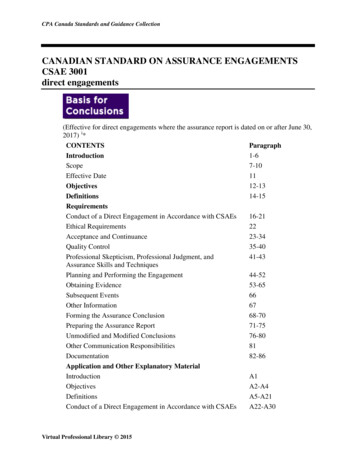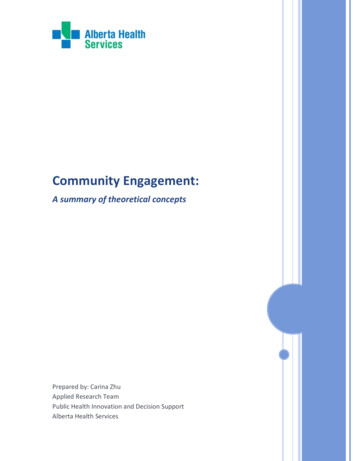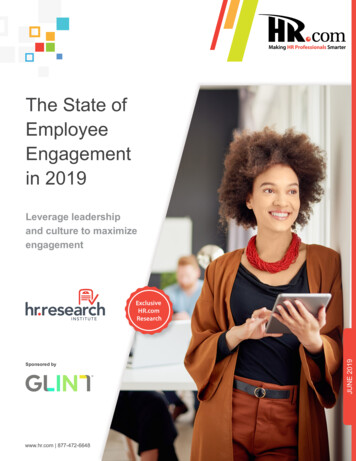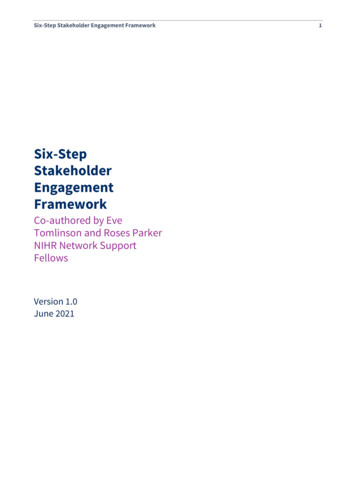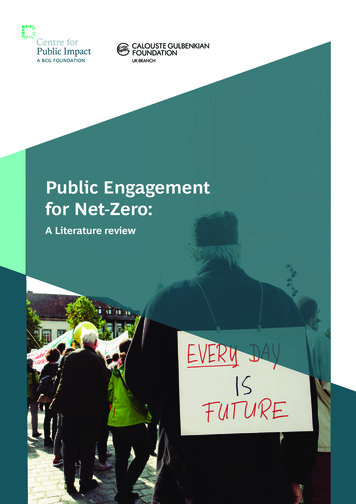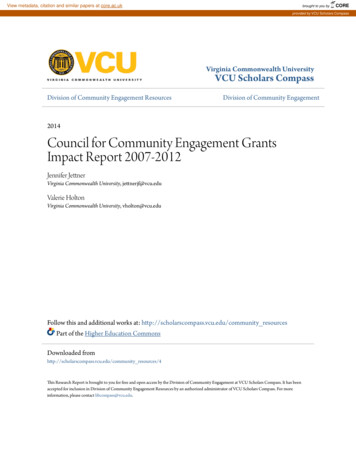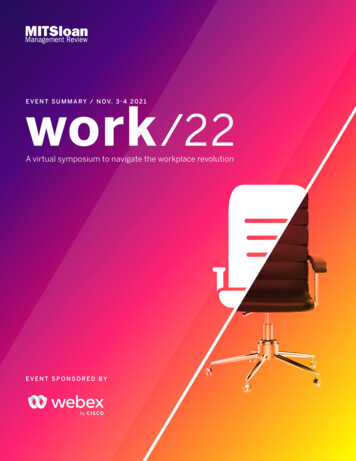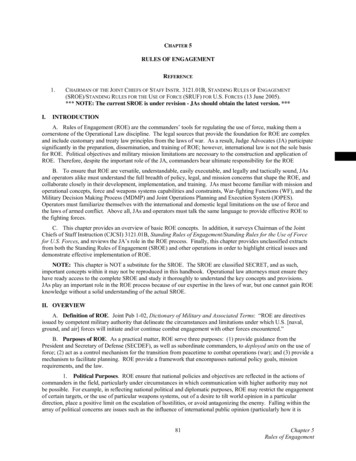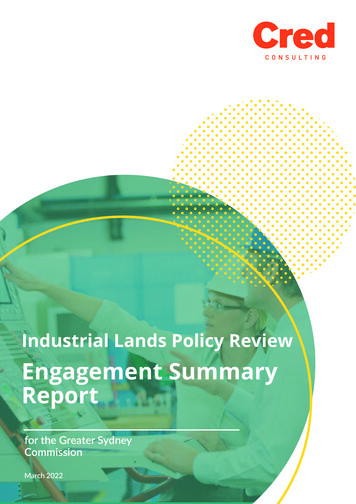
Transcription
Industrial Lands Policy ReviewEngagement SummaryReportfor the Greater SydneyCommissionMarch 2022
“A big priority for top tier city regions isshaping and supporting the industrialland market, amid scarce space and therise of e-commerce, biotech, and hightech manufacturing.Economic disruption is forcingmetropolitan planners to actively devotetime to confront strategic agendasaround desired industry mix, futurevalue creation, and implications forwhat kind of spaces, mobility, andprecincts are needed.”– The Business of Cities (2021)for the Greater Sydney CommissionReport title: Industrial Lands Policy ReviewEngagement Summary ReportClient: Greater Sydney CommissionDate: March 2022This material is made available by Cred Consulting on theunderstanding that users exercise their own skill and care withrespect to its use. Any representation, statement, opinion oradvice expressed or implied in this publication is made in goodfaith. Cred Consulting is not liable to any person or entity takingor not taking action in respect of any representation, statement,opinion or advice referred to in this document.Photos:Front cover: Western SydneyUniversity, Ideas LabInside cover: Cred Consulting
Table of contents1.Introduction 42.Phase 1 Engagement 6Industry Reference Group Local Government Reference Group Online survey and submissions3.Phase 2 Engagement 28Online survey and submissions4.Engagement on Review Findings 38Council Working Group and information sessions5.Appendix 44Appendix A1:Industry Reference Group members 45Appendix A2:Local Government Reference Group members 46Appendix A3:Phase 1 Survey Questions 48Appendix A4:Phase 2 Survey Questions 50Appendix A5:Phase 2 Information Session Q&A 51Appendix A6:Engagement on Review Findings Information Session Q&A 57
1. IntroductionThis report provides a summary of theengagement undertaken by Cred Consulting onbehalf of the Greater Sydney Commission to helpinform the review of the existing ‘Retain andManage’ policy.1.1. Background1.2. Engagement purposeThe Greater Sydney Commission (the Commission) isundertaking a review and evaluation of the Industrial andUrban Services Lands Retain and Manage policy underthe Greater Sydney Region Plan.This report provides a summary of the stakeholderengagement outcomes.The review follows a recent White Paper from the NSWProductivity Commission, Rebooting the Economy, whichincluded a recommendation to ‘optimise industrial landuse’.Specifically, Recommendation 7.5 states: Evaluate the retain-and-manage approach to managingindustrial and urban services land in Greater Sydneyagainst alternative approaches, to identify what wouldmaximise net benefits to the State.Adopt the approach that maximises the State’s welfare inthe next update to the Greater Sydney Region Plan.A key part of this review is engagement with GreaterSydney councils, peak bodies, advocacy groups andindustry representatives to collect feedback on theexisting policy and understand experiences.The Commission engaged Cred Consulting to design anddeliver stakeholder engagement to inform the review ofthe policy. This report is a summary of the engagementundertaken. Further reporting will be completed forfuture engagement undertaken for this project.4Cred ConsultingPhase 1 Engagement was undertaken between July andAugust 2021 to inform the review of the existing Retainand Manage policy.Phase 2 Engagement was undertaken in October 2021 togive stakeholders an opportunity to provide feedback onthe policy objectives and policy scenarios.Engagement on Review Findings was conducted betweenFebruary and March 2022 to support the finalisation ofthe review.Consultation aimed to: Collect constructive input and feedback on the existingpolicy. Listen to stakeholder views. Understand key challenges and benefits of the policy. Explore whether other employment uses can beallowed in industrial and urban services land, whilemaintaining essential industrial activity. Collect qualitative data and evidence to inform thepolicy review.
1.3. Phase 1 Engagement activitiesWritten submissions/online surveyLocal Government Reference GroupsThe Greater Sydney Commission acceptedwritten submissions through an online surveyas a way for reference group members, theirmembers and wider industry stakeholders toprovide feedback on the existing Retain andManage policy.Five Local Government Reference Groups werecreated across each of Greater Sydney’s districts:53 survey responses were received fromCouncils, industry representatives,professional organisations and propertysector representatives.Industry Reference GroupAn Industry Reference Group was created toprovide an opportunity for relevant stakeholdersto provide constructive input and feedback onthe evaluation of the existing retain and managepolicy.The Industry Reference Group was chaired bythe CEO of the Greater Sydney Commission. Central City District Western City District Eastern City District South District North District.One representative from each council wasinvited to be a member of the Local GovernmentReference Group for their district, and they weregiven the opportunity to provide constructiveinput and feedback on the evaluation of theexisting Retain and Manage policy.The Local Government Reference Groups werechaired by their relevant District Commissioners.The Commission extended an invitation toWollongong, Central Coast and Newcastlecouncils to participate as observers.1.4. Phase 2 Engagement activitiesIndustry information sessionOnline surveyAn online information session was hosted toupdate industry stakeholders on the policyreview, present the policy objectives and policyscenarios, and provide an opportunity forstakeholders to ask questions.The Commission conducted an online survey togain input from industry stakeholders, includingthe organisations represented on the IndustryReference Group, and their members to providefeedback on the policy objectives and policyoptions.Local Government information session50 survey responses were receivedduring the submission period from LocalGovernment, State Government, industryrepresentatives, professional organisationsand property sector representatives.Submissions were also received outside thesubmission period.An online information session was hosted toupdate Local Government stakeholders on thepolicy review, present the policy objectives andpolicy scenarios, and provide an opportunity forstakeholders to ask questions.1.5. Engagement on Review FindingsCouncil Working GroupStakeholder information sessionsThe Commission established a Council WorkingGroup to provide local government input intothe Policy design and inform the approachto implementation. Council Working Groupmembers were engaged via three meetings.Two online information sessions were heldto inform stakeholders about the draft Policyrecommendations, the intended implementationapproach and the connection with the broaderstrategic planning work that will be undertakenby the Commission. Stakeholders were alsogiven the opportunity to ask questions of theproject team. 5
2. Phase 1 Engagement (July-August 2021)As part of the Phase 1 Engagement, the following is a summary of the key themes from workshopdiscussions and written submissions/online survey about the current benefits, existing policy challengesand opportunities to consider in the ‘Retain and Manage’ policy review. The workshops were held withLocal Government Reference Groups (segmented based on their district and chaired by relevant DistrictCommissioners), and Industry Reference Groups (segmented into property sector representatives andindustry sector representatives, and chaired by the Greater Sydney Commission’s CEO). The survey wasavailable on the Commission’s website and open to all interested stakeholders.Strong support for the existing policy, though there may be benefit in refining it to respondto changing needs. Local Government representatives generally expressed support for the existing policy, noting thatit has been effective in managing the pressures on industrial lands from other uses. There wassome acknowledgment that a more nuanced planning approach is required to respond to the keyconstraints and differences between industrial uses and districts across Sydney. Property sector peak bodies stated that the policy needs to be more flexible, recognising thatwhile some industrial areas need to be protected (although what it is we are trying to protect wasqueried), others may be underutilised, or will evolve organically over time. Some stakeholders didsuggest, however, that the Retain and Manage policy should be abandoned. Industry representatives strongly support the policy and suggested that it requires strengthening toprotect existing industrial land and critical industry operations.The definition of industrial land use is evolving and future policy must support traditionaland emerging activities. Local Government, industry sector peak bodies and property sector peak bodies all noted that theway we define industrial lands and the activities occurring on them is dynamic and evolving. Thefuture policy needs to plan for and support emerging industries and future ways of working, as wellas protect industries (i.e. urban services) that are critical to a well-functioning city. Local Government and property sector peak bodies noted that the design approach to industrialareas is changing to maximise the use and potential of sites, as well as the importance of increasedamenity expectations of workers and businesses. Local Government noted the need to protectindustrial land to allow this market-based evolution to occur. Industry representatives highlighted that sensitive land uses in proximity can result in operationallimitations. Consideration of the location and design of these types of uses is important to protectthe viability of industrial activities and their operations.Leadership, collaboration and communication about the importance of industrial lands.6Cred Consulting There is a Desire from Local Government, industry sector peak bodies and property sectorpeak bodies for the Commission to provide leadership and strategic direction for the planningfor industrial land across Greater Sydney, and having a broader view of the macro drivers andsignificant precincts. A more nuanced approach to the application of the principles for industrial lands is needed tobetter understand the value that different industrial lands precincts provide for local, regional,metropolitan, state and national economies. Local Government and industry sector representatives noted that improved education andcommunication about the value of industrial lands in relation to the functioning of the city iscritical to their retention.
Mixed views on the appropriateness of other land uses on industrial lands. Industry representatives were concerned with the reduction of industrial land and encroachmentfrom competing land uses, primarily residential and mixed use. They identified increased landprices, decreased operational effectiveness, increased costs of goods and reduced supply chainsustainability as being the key impacts. Some property sector peak body representatives noted underutilisation of existing industrial landas an issue. They view this as an opportunity to alleviate other land use pressures that GreaterSydney faces (primarily residential and mixed use). It was also noted that re-purposing vacant orunderutilised industrial sites would maximise the land value. Local Government representatives noted the importance of the policy in protecting land forindustrial activities, especially in instances where retail and residential uses are encroaching onindustrial areas and contributing to the ongoing loss of industrial land.Local Government representatives agreed that industrial lands are vital to a well-functioning cityand must be distributed evenly across Sydney to achieve the vision for a 30-minute city. However,they also noted that every Local Government Area (LGA) is different, and councils are best-placedto understand their own needs and challenges and adequately respond. The key considerationsidentified were: Significant loss of industrial landand growth in knowledge-intensiveemployment, health and education sectorsin recent years, alongside substantialpopulation growth and changingemployment needs. Varying demand for and availability ofindustrial lands across the district. Key precincts such as Westmead, Camellia,Lidcombe and Greater Parramatta toOlympic Peninsula. Predicted future shortfall of industrial landin the district due to high demand andforecast population growth. Providing jobs in the district to reducetravel for people is a priority. Eastern District Lack of servicing to new industrial land isa barrier and relationship to rural landsneeds to be considered.Key precincts such as Western SydneyAirport precinct and Leppington.South District High proportion of industrial land, lowvacancies but uses across the district arediverse and have different needs. There are core industrial areas in the districtthat are strategically important to GreaterSydney and must be retained. Many older industrial areas are small andconstrained by surrounding residentialuses, restricting uses and viability of someindustries.North DistrictWestern DistrictCentral DistrictEvenly-distributed industrial lands and activities are vital to a well-functioning, 30-minutecity. Achieving even distribution will require different approaches across the GreaterSydney Districts. Industrial land is scarce and must be usedstrategically. Affordability and lack of suitablespace availability also impacting on theretention of new businesses. Increasing interest of industrial land linked tohealth and education uses. Increased demand for logistics, knowledgeindustries, bulky goods, start-ups, creativeuses and artisan food production. Maritime and working waterway usescontinue to be important parts of the district’sindustrial ecosystem. Significant national and global trade gateways with Port Botany, Sydney Airport and Sydney CBDand supporting uses. Affordability and availability of industrial land is challenging, particularly for the location of urbanservices and creative uses. Agglomeration is an important consideration and the benefits of a cluster of companies andservices and protection of key logistics corridors and supply chains to productivity. Increased recognition of the importance of industrial uses along the Parramatta Road corridor andretention of these lands. 7
Industry Reference GroupThe Industry Reference Group was created toprovide an opportunity to hear from a diversecross section of industry representatives to provideconstructive input and feedback on the evaluationof the existing Retain and Manage policy.The Industry Reference Group was chaired by the GreaterSydney Commission CEO and has a membership of 17invited organisations.Industry Reference Group members were from thefollowing organisations and separated into two groupingsfor Phase 1:The purpose of the Industry Reference Group was to helpconsider an evidence-base and issues relevant to thepolicy, to inform options and advice to the Commission.Peak bodies from the property sector Business Western SydneyFor Phase 1, the meetings of the Industry ReferenceGroup were held on 12 July and Thursday 15 July 2021 viaonline video platform. Business Sydney Urban Taskforce Planning Institute of AustraliaFor Phase 1, the Reference Group was split into twoseparate workshops with different members in each, toallow for ease of discussion in an online format. Property Council of Australia Urban Development Institute of Australia Committee for SydneyThe representatives from Cement Concrete & AggregatesAustralia and Sydney Fringe Festival were unable toattend meeting 1; however the Commission organised adebrief with the stakeholders shortly after the meeting tocollect feedback. Real Estate Institute of NSW.Peak bodies from the industry sector Sydney Airport Australian Industry Group Waste Contractors and Recyclers Association of NSW Cement Concrete & Aggregates Australia Shopping Centre Council of Australia Sydney Fringe Festival NSW Ports Australian Logistics Council Western Sydney Airport Large Format Retail Association.See Appendix A1 for a full list of Industry ReferenceGroup members.8Cred Consulting
2.1. What we heard from IndustrySeveral key themes emerged during the IndustryReference Group meetings.Views on the Retain and Manage policyWhile recognising the benefit of the Retain and Managepolicy and the value of industrial land, many peak bodiesfrom the property sector generally stated that the policyis too restrictive and inflexible. They indicated supportfor a more adaptable approach that allows for a range ofland uses to accommodate future market needs.Conversely, peak bodies from the industry sectorindicated strong support for the policy and the conceptof retaining existing industrial land and buffer zones tosupport critical industry operations.Need for a nuanced planning approachIndustry Reference Group members generally agreedthat a more nuanced planning approach is required,with a greater appreciation of the key constraints anddifferences between industrial lands across Sydney.Some members noted that the policy needs to be moreflexible, recognising that while some industrial areasneed to be protected to support the economy, othersmay be underutilised or will evolve organically over time.This sentiment was particularly prevalent among thepeak bodies from the property sector. The peak bodiesfrom the industry sector generally indicated that it iscritical to retain existing industrial land and buffer zonesin order to support important industrial operations thatpower the city.Mixed-use development as a tool to increasehousing supplyMany peak bodies from the property sector saw theintroduction of mixed-use and residential developmentsinto industrial areas as an effective tool to provide muchneeded housing to the community.Protecting significant freight corridors andnational and global trade gateways is critical tothe prosperity of NSWMany peak bodies from the industry sector expressedthe need to maintain the integrity and functionality ofimportant domestic and internal freight corridors thatconnect important industrial areas within Greater Sydney.The encroachment – not only on the industrial landsthemselves, but also the corridors – can result in a moreunsustainable supply chain, operational limits on vehiclemovements and local traffic congestion. This can causevaluable time and additional costs, which are ultimatelypassed on to the consumer. It is also important thatsignificant trade gateways and industrial hubs havethe ability to expand operations to respond to marketdemand. This is particularly the case with the movementof goods to and from Greater Sydney.Loss of industrial land and encroachment byother land usesMany peak bodies from the industry sector expressedstrong concerns around the continual loss of industrialland and encroachment by other land uses, primarilyresidential and mixed-use.They indicated that this not only increases land prices,increases costs of goods and reduces supply chainsustainability, but it also impacts resilience in Sydney.Some peak bodies from the industry sector highlightedthe importance of considered building design to ensureresidential developments located in close proximity toindustrial areas are protected from noise impacts.They noted that repurposing vacant or underutilisedindustrial sites into residential uses would maximisethe land value and achieve the best use of the land,particularly along sought-after waterways. 9
2.2. Workshop summariesPeak bodies from the property sectorWhat are your organisation/members’ views and/orexperience of the current Retain and Manage industrial landpolicy? What are the benefits and challenges from a policyperspective?Several peak bodies from the property sector indicatedthat their members have expressed concern with theRetain and Manage policy and, as a result, supportthe review. They noted that the existing policy is toorestrictive, emphasising the need for a more flexible,nuanced and adaptable approach to industrial lands.There was also a recognition that while some areas needto be protected to support the economy, industrial landsalready evolve organically over time to accommodatechanging market needs.Some peak bodies from the property sector indicatedthat the role of strategic planning is critical to set astrong approach and supporting objectives in relation toindustrial land especially given the competitive housingmarket in NSW.Some peak bodies from the property sector stated thatis important to have mechanisms in place to protectindustrial lands. However, others stated that the focusneeds to be less about protecting industrial lands andinstead about planning for the future – noting that theindustry has already evolved away from traditionalindustrial land uses. It was also noted that LocalGovernment can often be too rigorous and inflexiblewhen implementing the policy, reflecting the challengeassociated with implying protection.Some peak bodies from the property sector expressedthe need for mixed-use and residential developmentthat supports jobs and urban services, while increasinghousing supply in Sydney. However, other peak bodiesfrom the property sector indicated that once industrialland has changed to residential land, it does not have theability to reverse back. There is therefore an underlyingbarrier associated with taking risks on scenarios thatwould reduce the availability of land for productive, nonresidential purposes.10Cred ConsultingFrom your organisation/members’ perspective, what arethe current challenges for industrial and urban lands withinGreater Sydney?Peak bodies from the property sector raised severalkey challenges for industrial and urban lands in GreaterSydney.Some questioned why industrial sites that have beenvacant for long periods of time are being protected.They noted that many of these sites should be usedfor residential and retail purposes to increase housingsupply, particularly when they are located alongwaterways.Several peak bodies from the property sector stated thatwhile some urban services development is required tosupport residential and commercial users, a more flexibleway of achieving this outcome would be mixed-usedevelopment, as it provides employment opportunities.However, other peak bodies from the property sectornoted that while strategic planning can respond to andaccommodate changing market needs through mixeduse development, what remains is a scarcity of land forindustrial and urban services uses.Some peak bodies from the property sector stated thatthe limitations on permissible land uses within industrialzones is a key factor that holds back development onthose sites. They also noted that it is critical to speak toindustries about their needs, and implement the findingsinto the policy review.From your organisation/members’ perspective, what aspectsof the policy review do you consider to be most important?Some peak bodies from the property sector expressedconcern about the Commission working behind closeddoors, noting that further opportunities to provide inputbefore the analysis is complete is critical.
Peak bodies from the industry sectorWhat is your organisation/members’ views and/or experienceof the current Retain and Manage industrial land policy?What are the benefits and challenges from a policyperspective?Most peak bodies from the industry sector indicatedstrong support for the Retain and Manage policy, notingthat it is critical to retain appropriate industrial land andbuffer zones. Several peak bodies from the industrysector noted that while their members may not be awareof the Retain and Manage policy, they anticipated that thegeneral approach would be supported.Many peak bodies from the industry sector expressedconcern about the ongoing loss of industrial land andencroachment by competing land uses. This increasesland prices and forces businesses to relocate outsideof Sydney, and in some cases interstate or overseas– resulting in a more unsustainable supply chain andadditional costs associated with transporting goodsback into Sydney, which are ultimately passed on to theconsumer.Peak bodies from the industry sector emphasised theimportance of buffers and appropriate housing designfor residents living in close proximity to industrial areas.This would reduce noise complaints and subsequentgovernment restrictions on industrial operations.Some peak bodies from the industry sector also notedthat manufacturing locations impact purchase decisionsfor Australian consumers, and when businesses arerequired to relocate away from their market, they losethis selling point.Peak bodies from the industry sector generally statedthat the Retain and Manage policy has been veryimportant in recent years, helping to address thecontinual loss of industrial land and recognising theeconomic contribution provided by industrial areas.However, some peak bodies from the industry sectornoted that the policy does not address every challenge.Many peak bodies from the industry sector sharedexperiences specific to their industry group, includingconcerns from members around preservation of freightcorridors and industrial land, retail uses being built out ofcentres and contradictory permissible uses.From your organisation/members’ perspective, what arethe current challenges for industrial and urban lands withinGreater Sydney?Peak bodies from the industry sector raised several keychallenges for industrial and urban lands in GreaterSydney.Many peak bodies from the industry sector indicated thatthe most prominent challenges are the loss of industrialland, encroachment by other uses, inappropriatedevelopment around industrial land, as well as a lackof effective noise-mitigating technologies in residentialdevelopments surrounding industrial land. They notedthere is a perception that urban development is morevaluable than industrial uses, and that industrial landis underutilised due to low numbers of staff workingat industrial sites. They emphasised that a differentlens must be applied when determining utilisation andcontribution to the economy.Some peak bodies from the industry sector stated thatregulations are needed to prevent encroachment andensure buildings are designed with noise-mitigatingtechnologies. One peak body from the industry sectornoted that freight is a critical part of a liveable cityand there needs to be greater consideration aroundappropriately-sized land supply. The rise of ‘NIMBYism’was also cited as a key challenge, as a result of thesignificant encroachment into existing industrial land.Many peak bodies from the industry sector alsoexpressed concern about supporting land addingpressure to industrial land, with increases in density andno corresponding investment in transport infrastructure.One peak body from the industry sector noted that whileland supply is not an issue for them, the challenge isassociated with infrastructure provision and servicing theland to ensure it is available for industry uses.Several peak bodies from the industry sector notedthat market and industry trends have contributedto challenges. This includes the rise in e-commerce,resulting in more freight coming into Sydney, more truckscollecting different types of recyclables due to increasedwaste generation, as well as distribution trends such as‘click and collect’ services requiring retailers to use theirstores to distribute stock. 11
Local Government Reference GroupThe Local Government Reference Groups werecreated to provide an opportunity for councilsacross Greater Sydney to provide constructiveinput and feedback on the evaluation of theexisting Retain and Manage policy.The Local Government Reference Groups were createdin alignment with each of Greater Sydney’s districts.Therefore, the larger Reference Group was split intofive sub-groupings, with one representative from eachcouncil invited to be a member. The Local GovernmentReference Groups were chaired by their relevant DistrictCommissioner.South DistrictThe Commission also extended an invitation toWollongong, Central Coast and Newcastle councils toparticipate as observers.Eastern City DistrictThe purpose of the Local Government Reference Groupswas to help consider an evidence-base and issuesrelevant to the Retain and Manage policy, to informoptions and advice to the Commission.For Phase 1, the Local Government Reference Groupsmet on 26, 28 and 29 July 2021 via online video platform.The Local Government Reference Group sub-groupswere:Western City DistrictChaired by Liz Dibbs, District Commissioner Fairfield City Council Hawkesbury City Council Campbelltown City Council Wollondilly Shire Council Liverpool City Council Penrith City Council Camden Council Blue Mountains City Council.Central City DistrictChaired by Peter Poulet, District Commissioner Blacktown City Council The Hills Shire Council Cumberland City Council City of Parramatta Council.12Cred ConsultingChaired by Peter Poulet, District Commissioner Georges River Council Canterbury Bankstown Council Sutherland Shire Council.Chaired by Deborah Dearing, District Commissioner Randwick City Council City of Canada Bay Council City of Sydney Council Inner West Council Burwood Council Bayside Council Strathfield Council Waverley Council.North DistrictChaired by Deborah Dearing, District Commissioner Lane Cove Council Willoughby City Council Northern Beaches Council North Sydney Council Mosman Municipal Council Hunters Hill Council Hornsby Shire Council Ku-ring-gai Council City of Ryde Council Wollongong City Council (observer) Central Coast Council (observer)See Appendix A2 for a full list of Local GovernmentReference Group members.
2.3. What we heard from LocalGovernmentSeveral key themes emerged during the LocalGovernment Reference Group meetings.Strong support fo
- The Business of Cities (2021) . The Commission engaged Cred Consulting to design and deliver stakeholder engagement to inform the review of the policy. This report is a summary of the engagement . Plan review to apply a risk-weighted approach (net community benefit) only to those sites that are
